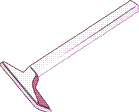What to Know
Contents
 Shaving
Shaving
This is by far the cheapest and least permanent method of hair removal. With practice and patience you can achieve a smooth look for only the cost of a good razor and a decent set of makeup. It works everywhere on your body, but beware: once shaved, hair grows in thicker and darker than before.
On your face, use whatever it takes to get the closest shave you can, then follow with a mild moisturiser before applying makeup. On your legs, arms, chest, underarms (and shoulders if necessary), shave closely, possibly working in both directions to catch all the hair growth patterns. Follow up with a good loofah vigorously applied; this will minimise ingrown hairs.
You don’t need to use expensive shaving cream; ordinary shampoo works quite well. Be prepared for some itching in the next few days as your hair begins growing back this is also an important time to loofah!
 Depilatory creams
Depilatory creams
These are chemical lotions you apply where you want to remove hair. They’re extremely strong and are not recommended for use on your face unless you’re going to a Hallowe’en party as Freddy Krueger. They may not be as effective if your hair is very coarse.
Common brands are Neet and Nair. Modern formulations don’t smell quite as strong as they used to.

 Plucking
Plucking
For retouching eyebrows or tiny problem areas, a good pair of tweezers and a firm, steady hand are the best way to go. For larger areas like face or legs, devices like the Epilady or Silk-Epil are suitable. They’re available at the cosmetics departments of larger drug stores or department stores. Looking rather like an electric shaver, these appliances actually grip and pull out the hair rather than cutting it. Remarkably painful, but also remarkably effective. Smooth on tea-tree lotion afterwards to soothe your skin. A vigorous loofahing in the bath will reduce ingrown hairs.
The disadvantages include the time required and the pain, as well as the three or four days lead time required before your hairs are long enough to grip and the hour or so afterwards to let your skin lose its redness. Advantages include smooth, hair-free skin for a week or two and slower regrowth than with shaving.
 Waxing
Waxing
This tried and true method works almost everywhere except on your face. Even eyebrows can occasionally be waxed.
Salon waxing is usually priced as half leg (ankle to knee) and full leg (lower and upper leg), including both legs, of course. A bikini wax is usually in addition to a full leg and clears hair that would show outside a bikini bottom. You can have chest, shoulders, back and arms waxed as well. There are several types: warm wax and cold wax. Salons invariably use warm wax for best results.
You’ll also hear about Rio and Brazilian waxing. On a woman, the Rio leaves only a very narrow central “landing strip”, and the Brazilian completely removes all hair. You can imagine why these are not well suited to the male anatomy.
Home kits are available in warm or cold types. Cold wax is most effective on light hair growth. Warmed wax is spread on your skin in the direction of hair growth, then cloth strips are pressed into it. As it cools, the strips are pulled off rapidly in the opposite direction, removing the wax and the hair. It takes practice or a helpful partner to do it right at home, but the results are worth it. Make very sure you stretch the skin slightly as you pull the strip off or you risk bruising.
Disadvantages are the cost if you go to a salon, some discomfort and about an hour or so of redness. Tea-tree oil will soothe your skin afterwards. As with any hair plucking method, ingrown hairs can be reduced with a vigorous loofahing. Advantages include finer and slower hair regrowth after each treatment, and hair-free skin for up to several weeks.
Sugaring
This is similar in principle to waxing (pulling out hair with something sticky). It is somewhat less painful and you can use warm water to clean up. A few salons offer sugaring. Home kits are available in drug stores and on the Home Shopping Channel.
Electrolysis
This is a permanent method of hair removal. It is expensive and requires many hours of meticulous work by a trained electrologist. It can be used anywhere on the body, although it’s most commonly used for beard removal. The process involves grasping individual hairs with a special instrument and either passing an electrical current or a pulse of heat or a combination of the two down the hair to kill the follicle. There’s some discomfort or pain involved, although people’s tolerance varies widely. The upper lip is generally considered to be the most painful.
Disadvantages include the large commitment of time and money, the discomfort, the risk of scarring (temporary or permanent), the lead time to let your hair grow long enough to treat and the recovery time after each session (freshly treated skin is prone to infection and will usually not tolerate makeup for a day or two). Electrolysis is also permanent; you can’t change your mind and you may have some explaining to do to family and friends. However, its permanence is also its chief advantage.
Rates are per hour and can vary widely. Shop around and get estimates of the time involved for your needs. Sometimes you can get a deal at an esthetics school where you’re worked on by students under supervision.
Laser Hair Removal
This is the latest technological method of permanent hair reduction. Like electrolysis, it can be used anywhere on the body and involves killing the hair follicles. It uses intense pulses of light from a special laser. There are two main types: melanin-guided and carbon-guided, referring to how the heat from the laser is carried down to the follicle to kill it. Melanin-guided lasers rely on the dark pigment of the hair to absorb the laser energy and transmit it to the follicle. They work best on light skin and dark hair. Carbon-guided lasers employ a special carbon lotion rubbed on the skin. The carbon accumulates in the follicles and absorbs the laser energy with the same fatal effect. Carbon-guided lasers seem to work better on multicoloured hair or where there is less contrast between hair and skin colour. Six to eight treatments are usually sufficient to clear any area.
Unlike electrolysis, laser hair reduction cannot be advertised as permanent hair removal; it is simply an effective, if impermanent, method of hair reduction.
Disadvantages include high cost, a year’s commitment to treatment, the usual recovery time after each session and the inability to change your mind once you’ve started. You must avoid any kind of suntan, sunburn or skin irritation during the course of treatment.
Advantages are its much lower cost and few treatments compared to electrolysis, and the longevity of the result. Rates vary and have been dropping in recent years. Some are on a flat contract rate; others are per session. Shop around. Look for a place that has a dermatologist on staff or on consultation. Make sure you ask about post-procedural skin care.


